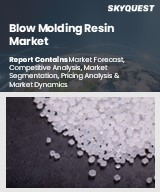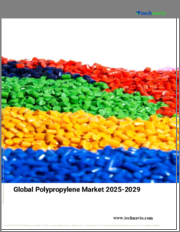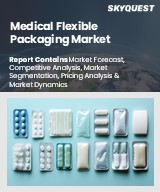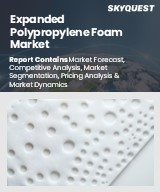
|
시장보고서
상품코드
1438443
폴리프로필렌 : 시장 점유율 분석, 산업 동향 및 성장 예측(2024-2029년)Polypropylene - Market Share Analysis, Industry Trends & Statistics, Growth Forecasts (2024 - 2029) |
||||||
폴리프로필렌 시장 규모는 2024년 9,198만 톤으로 추정됩니다. 2029년에는 1억 2,181만 톤에 달할 것으로 예상되며, 예측 기간(2024-2029년) 동안 5.78%의 연평균 복합 성장률(CAGR)로 성장할 것으로 예상됩니다.
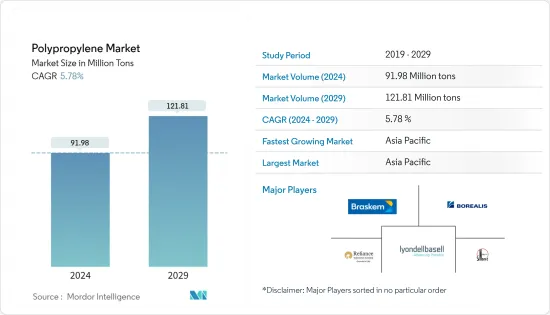
코로나19로 인해 폴리프로필렌 수요는 다소 감소했습니다. 폴리프로필렌 수요가 높은 건설 및 자동차 부문은 큰 폭의 둔화를 보였습니다. 주요 최종 사용자 산업의 재가동으로 인해 2022년에는 큰 폭의 회복세를 보였습니다.
주요 하이라이트
- 단기적으로는 자동차 경량화 및 연비 향상을 위한 플라스틱 사용 증가, 연포장에 대한 수요 증가가 시장을 주도하는 주요 요인입니다.
- 한편, 시장에 다양한 대체 제품이 존재한다는 점은 예측 기간 동안 대상 산업의 성장을 억제할 것으로 예상되는 주요 요인입니다.
- 재생 폴리프로필렌 증가 추세는 향후 기회로 작용할 가능성이 높습니다.
- 아시아태평양이 전 세계 시장을 장악하고 있으며, 예측 기간 동안에도 중국, 인도와 같은 국가들의 소비가 가장 커서 시장을 장악할 것으로 예상됩니다.
폴리프로필렌 시장 동향
사출성형에 대한 수요 증가가 용도별 부문을 지배
- 폴리프로필렌은 주로 사출 성형에 사용되며, 주로 펠릿 형태로 제공됩니다. 폴리프로필렌은 성형이 용이하고 용융 점도가 낮아 유동성이 우수합니다.
- 사출 성형 기술은 전기 및 전자 응용 분야에 널리 사용되는 플라스틱을 제조하는 데 사용됩니다. 이 플라스틱은 전기 및 전자 장비 제조에 널리 사용됩니다.
- 폴리프로필렌은 다양한 용도로 사용되기 때문에 다양한 제품 유형에 적합합니다. 가장 많이 사용되는 용도 중 하나는 캡과 같은 소비재에 자주 사용되는 일체형 경첩 디자인인 리빙 힌지(Living Hinge)입니다. 이 공정을 통해 생산되는 제품에는 어린이 장난감, 스포츠 용품, 클로저, 자동차 부품, 식품 트레이, 컵, 테이크아웃 용기, 가정용품, 식기 세척기와 같은 가전제품 등 수많은 제품이 있습니다.
- 세계 유수의 소재 제조업체인 HUBS에 따르면, 폴리프로필렌은 전 세계 사출 성형 생산량의 35-40%를 차지하며, ABS(25%), 폴리에틸렌(15%), 폴리스티렌(10%) 등 다른 소재가 그 뒤를 잇고 있습니다.
- 전 세계적으로 포장 산업과 화학 가공 산업의 고성장으로 인해 사출 성형에 유리한 시장 시나리오가 예상됩니다. 빠르게 성장하는 아시아태평양으로의 유통이라는 지리적 이점으로 인해 사출 성형 팔레트의 소비가 크게 증가 할 수 있습니다.
- 또한, 연비를 개선하기 위해 자동차에 경량 부품을 채택하는 것은 예측 기간 동안 조사된 시장 수요에 유리하게 작용할 것으로 예상됩니다.
- 앞서 언급한 모든 요인들이 시장 수요를 끌어올릴 것으로 예상됩니다.
아시아태평양이 가장 빠른 성장세를 기록합니다.
- 아시아태평양의 폴리프로필렌 시장은 중국, 인도 등 국가들이 주도하여 빠른 속도로 성장하고 있습니다. 폴리프로필렌은 자동차, 소비재, 전자 및 포장 산업에서 널리 사용되고 있습니다. 이러한 산업의 견고한 성장과 정부의 지원으로 인해 폴리 프로파일렌에 대한 수요는 예측 기간 동안 건전한 속도로 증가할 것으로 예상됩니다.
- 중국은 세계 최대 자동차 시장이며, 앞으로도 연간 판매량과 생산량 모두에서 가장 큰 시장이 될 것이며, 국내 생산량은 2025년까지 3,500만 대에 달할 것으로 예상되고 있습니다.
- 또한 OICA에 따르면 중국 자동차 제조업체는 2021년에 2,608만 2,220대를 생산해 2020년 대비 3%의 성장률을 나타낼 것으로 예상했습니다.
- 인도에서는 인도 포장산업협회(PIAI)에 따르면 이 부문은 연간 22%에서 25%의 성장률을 보이고 있으며, 2025년에는 2,048억 1,000만 달러에 달할 것으로 예측되고 있습니다. 인도의 포장 산업은 수출과 수입에서 성과를 거두며 국내 기술 및 기술 혁신의 성장을 주도하고 다양한 제조업에 부가가치를 창출하고 있습니다.
- 포장 산업은 인도 폴리프로필렌 시장의 거대한 성장을 가속하는 촉매제 역할을 하고 있습니다. 또한, 지난 몇 년동안 인도에서는 포장 식품에 대한 수요가 크게 증가했으며, 이는 예측 기간 동안 지속될 것으로 예상되어 조사 대상 시장 수요를 증가시킬 것으로 예상됩니다.
- National Investment Promotion &Facilitation Agency에 따르면, 자동차 산업은 인도 GDP의 7.1%, 제조업 GDP의 49%를 차지합니다. 또한, Organisation Internationale des Constructeurs d'Automobiles에 따르면, 인도 자동차 산업은 2020년 439만 9,112대를 생산하여 2020년 대비 30% 가까이 증가했습니다.
- 이러한 다양한 산업의 성장은 예측 기간 동안 아시아태평양의 폴리프로필렌 시장을 견인할 것으로 예상됩니다.
폴리프로필렌 산업 개요
세계 폴리프로필렌 시장은 세분화되어 있습니다. 상위 5개 업체가 생산능력 기준으로 세계 시장 점유율의 약 35%를 차지하고 있습니다. 주요 기업으로는 China Petroleum &Chemical Corporation(SINOPEC), LyondellBasell Industries Holdings BV, Borealis AG, Braskem, Reliance Industries Limited 등이 있습니다.
기타 혜택 :
- 엑셀 형식 시장 예측(ME) 시트
- 3개월간의 애널리스트 지원
목차
제1장 서론
- 조사의 전제조건
- 조사 범위
제2장 조사 방법
제3장 주요 요약
제4장 시장 역학
- 성장 촉진요인
- 성장 억제요인
- 업계 밸류체인 분석
- Porter의 Five Forces 분석
- 공급 기업의 교섭력
- 소비자의 교섭력
- 신규 진출업체의 위협
- 대체품의 위협
- 경쟁 정도
- 가격 동향
- 수출입 동향
- 원료 분석
- 기술 현황
제5장 시장 세분화
- 유형
- 호모폴리머
- 코폴리머
- 용도
- 사출성형
- 섬유
- 필름 및 시트
- 기타 용도(압출 코팅, 블로우 성형)
- 최종사용자 산업
- 포장
- 자동차
- 소비자 제품
- 전기 및 전자
- 기타 최종사용자 산업(섬유, 건설)
- 지역
- 아시아태평양
- 중국
- 인도
- 일본
- 한국
- ASEAN 국가
- 기타 아시아태평양
- 북미
- 미국
- 캐나다
- 멕시코
- 유럽
- 독일
- 영국
- 프랑스
- 이탈리아
- 러시아
- 기타 유럽
- 남미
- 브라질
- 아르헨티나
- 기타 남미
- 중동 및 아프리카
- 사우디아라비아
- 남아프리카공화국
- 기타 중동 및 아프리카
- 아시아태평양
제6장 경쟁 구도
- 인수합병(M&A)/합작투자(JV)/협업/협정
- 시장 점유율(%) 분석
- 주요 기업의 전략
- 기업 개요
- Borealis AG
- Braskem
- China National Petroleum Corporation
- China Petrochemical Corporation(SINOPEC)
- Daelim Co. Ltd
- Exxon Mobil Corporation
- Formosa Plastics Corporation
- INEOS
- LG Chem
- Lotte Chemical Corporation
- LyondellBasell Industries Holdings BV
- Mitsubishi Chemical Corporation
- Mitsui Chemicals Inc.(Prime Polymer Co. Ltd)
- Reliance Industries Limited
- SABIC
- SIBUR International GmbH
- Sumitomo Chemical Co. Ltd
- Total Energies
제7장 시장 기회와 향후 동향
LSH 24.03.18The Polypropylene Market size is estimated at 91.98 Million tons in 2024, and is expected to reach 121.81 Million tons by 2029, growing at a CAGR of 5.78% during the forecast period (2024-2029).

A slight decline in the demand for polypropylene has been observed due to COVID-19. A drastic slowdown was witnessed in the construction and automotive sector, where polypropylene is in high demand. With the resumption of operations in major end-user industries, it significantly recovered in 2022.
Key Highlights
- Over the short term, major factors driving the market studied are the increasing usage of plastics to reduce vehicle weight and enhance fuel economy and the growing demand for flexible packaging.
- On the other hand, the presence of different substitute products in the market is a key factor anticipated to restrain the growth of the target industry over the forecast period.
- The increasing trends of recycled polypropylene are likely to act as an opportunity in the future.
- The Asia-Pacific dominated the market across the world and is expected to dominate in the forecast period, with the largest consumption from countries such as China and India.
Polypropylene Market Trends
Increasing Demand for Injection Molding to Dominate the Application Segment
- Polypropylene is majorly used for injection molding and is mostly available for this application in the form of pellets. Polypropylene is easy to mold, and it flows very well because of its low melt viscosity.
- Injection molding technology is used to produce plastics that are used extensively in electrical and electronic applications. These plastics are widely used in the manufacturing of electrical and electronic devices.
- Polypropylene is well-suited to a wide range of product types due to its numerous flexible uses. One of the most frequent applications is the living hinge, a one-piece hinged design typically used in consumer items such as caps. Innumerable products made from the process include children's toys, sporting goods, closures, automotive applications, food trays, cups, to-go containers, household goods, and appliances like dishwashers.
- According to HUBS, a globally leading material manufacturing company, polypropylene accounts for 35-40% of worldwide injection molding output, followed by other materials such as ABS (25%), polyethylene (15%), and polystyrene (10%).
- The high growth of the packaging and chemical processing industries across the world is expected to offer a favorable market scenario for injection molding. Owing to the geographical advantage of distribution to the rapidly growing Asia-Pacific region, the consumption of injection-molded pallets may increase drastically.
- Moreover, the adoption of lightweight components for the automobile to increase fuel efficiency is expected to favor the demand for the market studied in the forecast period.
- All the aforementioned factors are expected to boost the market's demand.
Asia-Pacific to Register the Fastest Growth
- The Asia-pacific polypropylene market is growing at a fast pace, driven by countries like China and India. Polypropylene is widely used in the automotive, consumer products, electronics, and packaging industries. With robust growth in these industries and government support, the demand for polypropylene is projected to increase at a healthy pace during the forecast period.
- China is the world's largest vehicle market and will continue to be the largest market by both annual sales and manufacturing output, with domestic production expected to reach 35 million vehicles by 2025.
- Moreover, as per the OICA, Chinese automotive manufacturers manufactured 26,082,220 vehicles in 2021, registering a growth of 3% compared to 2020.
- In India, according to the Packaging Industry Association of India (PIAI), the sector is growing at 22% to 25% per annum and is expected to reach USD 204.81 billion by 2025. The Indian packaging industry made a mark with its exports and imports, driving technology and innovation growth in the country and adding value to the various manufacturing sectors.
- The packaging industry is enacting the role of catalyst in promoting the huge growth of the polypropylene market in India. Furthermore, the country has been exhibiting a significant demand for packed foods in the past few years, which is expected to continue during the forecast period, thus boosting the demand for the market studied.
- As per the National Investment Promotion & Facilitation Agency, the automobile industry contributes 7.1% of India's GDP and 49% of its manufacturing GDP. Moreover, according to Organisation Internationale des Constructeurs d'Automobiles, the Indian automotive industry manufactured 4,399,112 vehicles, which is almost 30% more than in 2020.
- Such growth in various industries is expected to drive the market for polypropylene in the Asia-Pacific region during the forecast period.
Polypropylene Industry Overview
The global polypropylene market is fragmented in nature. The top five companies hold around 35% of the global market share in terms of production capacities. Some of the major players in the market include China Petroleum & Chemical Corporation (SINOPEC), LyondellBasell Industries Holdings BV, Borealis AG, Braskem, and Reliance Industries Limited.
Additional Benefits:
- The market estimate (ME) sheet in Excel format
- 3 months of analyst support
TABLE OF CONTENTS
1 INTRODUCTION
- 1.1 Study Assumptions
- 1.2 Scope of the Study
2 RESEARCH METHODOLOGY
3 EXECUTIVE SUMMARY
4 MARKET DYNAMICS
- 4.1 Drivers
- 4.1.1 Increasing Usage of Plastics to Reduce Vehicle Weight and Enhance Fuel Economy
- 4.1.2 Growing Demand for Flexible Packaging
- 4.2 Restraints
- 4.2.1 Availability of Substitute Products
- 4.3 Industry Value Chain Analysis
- 4.4 Porter's Five Forces Analysis
- 4.4.1 Bargaining Power of Suppliers
- 4.4.2 Bargaining Power of Consumers
- 4.4.3 Threat of New Entrants
- 4.4.4 Threat of Substitute Products and Services
- 4.4.5 Degree of Competition
- 4.5 Price Trends
- 4.6 Import-Export Trends
- 4.7 Feedstock Analysis
- 4.8 Technological Snapshot
5 MARKET SEGMENTATION (Market Size in Volume)
- 5.1 Type
- 5.1.1 Homopolymer
- 5.1.2 Copolymer
- 5.2 Application
- 5.2.1 Injection Molding
- 5.2.2 Fiber
- 5.2.3 Film and Sheet
- 5.2.4 Other Applications (Extrusion Coating, Blow moulding)
- 5.3 End-user Industry
- 5.3.1 Packaging
- 5.3.2 Automotive
- 5.3.3 Consumer Products
- 5.3.4 Electrical and Electronics
- 5.3.5 Other End-user industries (Textiles, Construction)
- 5.4 Geography
- 5.4.1 Asia-Pacific
- 5.4.1.1 China
- 5.4.1.2 India
- 5.4.1.3 Japan
- 5.4.1.4 South Korea
- 5.4.1.5 ASEAN Countries
- 5.4.1.6 Rest of Asia-Pacific
- 5.4.2 North America
- 5.4.2.1 United States
- 5.4.2.2 Canada
- 5.4.2.3 Mexico
- 5.4.3 Europe
- 5.4.3.1 Germany
- 5.4.3.2 United Kingdom
- 5.4.3.3 France
- 5.4.3.4 Italy
- 5.4.3.5 Russia
- 5.4.3.6 Rest of Europe
- 5.4.4 South America
- 5.4.4.1 Brazil
- 5.4.4.2 Argentina
- 5.4.4.3 Rest of South America
- 5.4.5 Middle East and Africa
- 5.4.5.1 Saudi Arabia
- 5.4.5.2 South Africa
- 5.4.5.3 Rest of Middle East and Africa
- 5.4.1 Asia-Pacific
6 COMPETITIVE LANDSCAPE
- 6.1 Mergers and Acquisitions, Joint Ventures, Collaborations, and Agreements
- 6.2 Market Share(%) Analysis
- 6.3 Strategies Adopted by Leading Players
- 6.4 Company Profiles
- 6.4.1 Borealis AG
- 6.4.2 Braskem
- 6.4.3 China National Petroleum Corporation
- 6.4.4 China Petrochemical Corporation (SINOPEC)
- 6.4.5 Daelim Co. Ltd
- 6.4.6 Exxon Mobil Corporation
- 6.4.7 Formosa Plastics Corporation
- 6.4.8 INEOS
- 6.4.9 LG Chem
- 6.4.10 Lotte Chemical Corporation
- 6.4.11 LyondellBasell Industries Holdings BV
- 6.4.12 Mitsubishi Chemical Corporation
- 6.4.13 Mitsui Chemicals Inc. (Prime Polymer Co. Ltd)
- 6.4.14 Reliance Industries Limited
- 6.4.15 SABIC
- 6.4.16 SIBUR International GmbH
- 6.4.17 Sumitomo Chemical Co. Ltd
- 6.4.18 Total Energies
7 MARKET OPPORTUNITIES AND FUTURE TRENDS
- 7.1 Recycled Polypropylene






